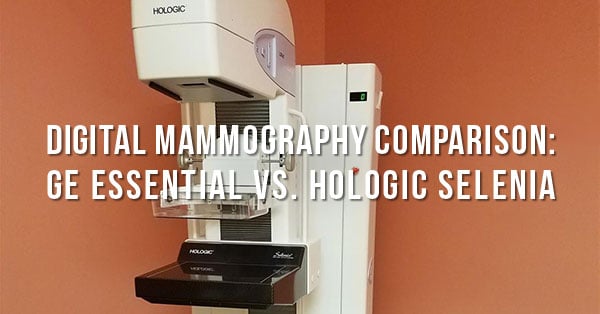
Updated: April 30, 2025 : 2 min read
GE Essential vs. Hologic Selenia: Digital Mammography Unit Comparison
At present, two of the more prominent players in digital mammography are GE and Hologic. If you're in the market for a digital mammo system, you won't get very far into your product homework before seeing both of these names surface.
For those of you that are considering the secondary market for a late-model, large-detector mammo unit, the latest used systems that you're likely to find from these manufacturers are the Senographe Essential from GE and the Selenia from Hologic. To help you learn more, we've compiled a side-by-side comparison of some of the key features of these systems.
Digital Mammo Comparison
Detector Size (cm)
Larger mammo detectors come with a number of advantages including: patient comfort, dose reduction, and the ability to more easily and efficiently scan larger/denser-breasted patients. Both the Essential and the Selenia feature larger detectors.
- Essential: 24 x 30.7
- Selenia: 24 x 29
Conversion Method
Within digital mammography, there are two primary methods of converting an X-ray signal into an image: indirect conversion and direct conversion. Although the difference is not drastic, it should be noted that, in terms of image quality, direct conversion is regarded as the superior method.
- Essential: Indirect conversion
- Selenia: Direct conversion
Detectors
Material- Digital mammography machines feature detectors made from a variety of materials. The properties of these materials go hand-in-hand with their respective conversion methods and the image quality levels of those methods.
- Essential: Amorphous Silicon (indirect conversion)
- Selenia: Amorphous Selenium (direct conversion)
Biopsy Integration
Some digital mammography units can be integrated with biopsy systems to expand their capabilities.
- Essential: Eligible for biopsy integration
- Selenia: Only Selenia units designated as "stereoloc ready" are eligible for biopsy integration
System Pricing (refurbished system+ installation and 1-year warranty)
For the budget-conscious equipment buyer, there is definitely money to be saved by purchasing your digital mammo used or refurbished. The price you pay will vary depending on the age of the system and what level of ongoing service you choose. So, how much should you expect to pay for either of these? The numbers below include delivery, installation, and the first year of service coverage.
- Essential: $60,000 - $95,000*
- Selenia: $60,000 - $95,000*
*pricing based on domestic sale, accessory (CAD, RWS, biopsy, etc.) pricing available upon request
Consider A Mammo Subscription
Rather than purchasing a system and tapping into capital dollars, domestic buyers can now use operating dollars in the form of a monthly subscription. Built into this payment model is the ability to upgrade the equipment at the end of the subscription term (i.e. 3D mammography). A typical payment for a GE Essential 2D or Hologic Selenia 2D mammography system ranges from $3,450-$4,200 per month, depending on model, features, and length of term. A bumper-to-bumper service agreement, including preventative maintenance, is built into the subscription price.
The Takeaway
Ultimately, these are both excellent systems that offer great image quality to serve patients accurately and with minimal discomfort (relatively speaking, of course) and radiation dose. For standard mammography procedures, you can't "go wrong" with either one. If you intend to upgrade your system for biopsy or 3D/Tomo functions, the Essential comes out on top at this point, if only for its higher availability.
If you have more questions about either of these models, we're happy to help answer them. Contact us to speak with our team directly or check out our free mammography resources for additional information.

Jason Block
Jason Block is the Product Manager for Women’s Health Equipment at Block Imaging. Jason loves to help, challenge, and empower people as they make decisions about their medical imaging equipment. When he's not assisting healthcare facilities with their imaging needs, Jason enjoys spending time with his family, coaching multiple sports, and watching the Michigan State Spartans.




